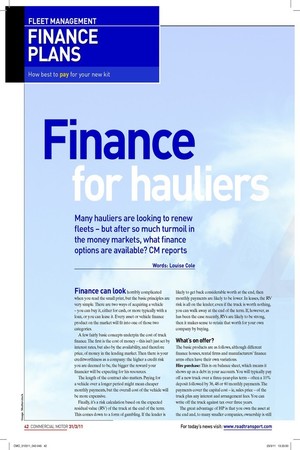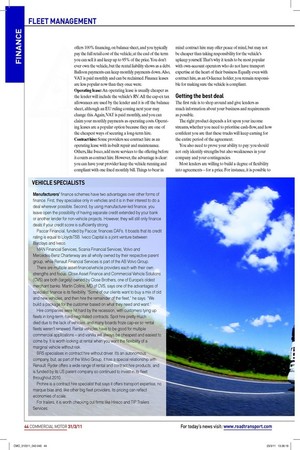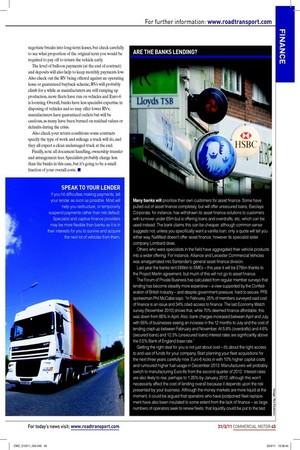nance
Page 32

Page 33

Page 34

Page 35

If you've noticed an error in this article please click here to report it so we can fix it.
for hauliers
Many hauliers are looking to renew fleets – but after so much turmoil in the money markets, what finance options are available? CM reports
Words: Louise Cole Finance can look horribly complicated when you read the small print, but the basic principles are very simple. There are two ways of acquiring a vehicle – you can buy it, either for cash, or more typically with a loan, or you can lease it. Every asset or vehicle inance product on the market will it into one of those two categories.
A few fairly basic concepts underpin the cost of truck inance. The irst is the cost of money – this isn’t just set by interest rates, but also by the availability, and therefore price, of money in the lending market. Then there is your creditworthiness as a company: the higher a credit risk you are deemed to be, the bigger the reward your inancier will be expecting for his resources.
The length of the contract also matters. Paying for a vehicle over a longer period might mean cheaper monthly payments, but the overall cost of the vehicle will be more expensive.
Finally, it’s a risk calculation based on the expected residual value (RV) of the truck at the end of the term. This comes down to a form of gambling. If the lender is likely to get back considerable worth at the end, then monthly payments are likely to be lower. In leases, the RV risk is all on the lender; even if the truck is worth nothing, you can walk away at the end of the term. If, however, as has been the case recently, RVs are likely to be strong, then it makes sense to retain that worth for your own company by buying.
What’s on offer?
The basic products are as follows, although different inance houses, rental irms and manufacturers’ inance arms often have their own variations.
Hire purchase: This is on balance sheet, which means it shows up as a debt in your accounts. You will typically pay off a new truck over a three-year-plus term – often a 10% deposit followed by 36, 48 or 60 monthly payments. The payments cover the capital cost – ie, sales price – of the truck plus any interest and arrangement fees. You can write off the truck against tax over three years.
The great advantage of HP is that you own the asset at the end and, to many smaller companies, ownership is still important as a concept and for future leverage. There is usually a transfer of ownership payment at the end, often about £75. Residual values have been rising throughout the recession as people held onto vehicles for longer and good, clean, used trucks became scarce.
However, there are downsides. With HP, you pay the VAT upfront, and can reclaim it in the next quarter. And, if you need borrowing for other things, you’ve just used up a line of credit.
Contract purchase: This is a variation, supported by most of the manufacturers, which keeps monthly repayments low with a guaranteed purchase payment at the end of the contract. If you think the RV of the truck will be higher than the inal balloon payment, then this can make sense, but you are left with a hefty inal payment. If the residuals are too low to justify the balloon payment, then you can return the truck. Monthly payments are higher than with contract hire, for example, as the manufacturer (or other lender) will only get the truck back if residuals are lower than the guaranteed payment.
Finance lease: With leases, you never own the vehicle. This offers 100% inancing, on balance sheet, and you typically pay the full retail cost of the vehicle; at the end of the term you can sell it and keep up to 95% of the price. You don’t ever own the vehicle, but the rental liability shows as a debt. Balloon payments can keep monthly payments down. Also, VAT is paid monthly and can be reclaimed. Finance leases are less popular now than they once were.
Operating lease: An operating lease is usually cheaper as the lender will include the vehicle’s RV. All the cap-ex tax allowances are used by the lender and it is off the balance sheet, although an EU ruling coming next year may change this. Again, VAT is paid monthly, and you can claim your monthly payments as operating costs. Operating leases are a popular option because they are one of the cheapest ways of securing a long-term hire. Contract hire: Some providers see contract hire as an operating lease with in-built repair and maintenance. Others, like Iveco, add more services to the offering before it counts as contract hire. However, the advantage is clear: you can have your provider keep the vehicle running and compliant with one ixed monthly bill. Things to bear in mind: contract hire may offer peace of mind, but may not be cheaper than taking responsibility for the vehicle’s upkeep yourself. That’s why it tends to be most popular with own-account operators who do not have transport expertise at the heart of their business. Equally even with contract hire, as an O-licence holder, you remain responsible for making sure the vehicle is compliant.
Getting the best deal
The irst rule is to shop around and give lenders as much information about your business and requirements as possible.
The right product depends a lot upon your income streams, whether you need to prioritise cash-low, and how conident you are that these trucks will keep earning for the entire period of the agreement.
You also need to prove your ability to pay: you should not only identify strengths but also weaknesses in your company and your contingencies.
Most lenders are willing to build a degree of lexibility into agreements – for a price. For instance, it is possible to negotiate breaks into long-term leases, but check carefully to see what proportion of the original term you would be required to pay off to return the vehicle early.
The level of balloon payments (at the end of contract) and deposits will also help to keep monthly payments low. Also check out the RV being offered against an operating lease or guaranteed buyback scheme; RVs will probably climb for a while as manufacturers are still ramping up production, more leets have run on vehicles and Euro-6 is looming. Overall, banks have less specialist expertise in disposing of vehicles and so may offer lower RVs; manufacturers have guaranteed outlets but will be cautious, as many have been burned on residual values or defaults during the crisis.
Also check your return conditions: some contracts specify the type of work and mileage a truck will do, and they all expect a clean undamaged truck at the end.
Finally, note all document handling, ownership transfer and arrangement fees. Specialists probably charge less than the banks in this case, but it’s going to be a small fraction of your overall costs. ■









































